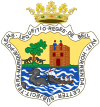Lekeitio
| Lekeitio | ||
|---|---|---|
| Municipality | ||
| Lekeitio | ||
 |
||
|
||
| Location of Lekeitio within the Basque Country | ||
| Coordinates: 43°21′44″N 02°29′46″W / 43.36222°N 2.49611°W | ||
| Country | Spain | |
| Autonomous community | Basque Country | |
| Province | Biscay | |
| Comarca | Lea-Artibai | |
| Government | ||
| • Mayor | José María Cazalis Eiguren | |
| Area | ||
| • Total | 1.90 km2 (0.73 sq mi) | |
| Elevation | 0 m (0 ft) | |
| Population (2009) | ||
| • Total | 7,477 | |
| • Density | 3,900/km2 (10,000/sq mi) | |
| Demonym(s) | Lekeitiarra (Spanish: Lequeitianos) | |
| Time zone | CET (UTC+1) | |
| • Summer (DST) | CEST (UTC+2) | |
| Postal code | 48280 | |
| Website | Official website | |
Lekeitio (Spanish: Lequeitio) is a town and municipality located in the province of Biscay, in the Spanish Autonomous Community of Basque Country, 53 km (33 mi) northeast from Bilbao. The municipality has 7,293 inhabitants (2005) and is one of the most important fishing ports of the Basque coast. Tourism has an important role during the summer seasons, when the town is a resort with one beach called Isunza and the nearby Carraspio beach in the town of Mendexa.
The most important monument is the church of Santa María, a gothic basilica from the 15th century. Lekeitio is also the birthplace of Resurrección María de Azkue, one of the most important Basque scholars of the 19th century.
The celebration of San Pedro takes place from June 29, saints day, to July 1. It begins with a mass in honor of the saint and a procession with his image. The mass is celebrated in the church of Santa Maria, and from there the procession starts to walk the streets of the town.
The festivities are in honor of the patron of the town, San Antolin, and are celebrated from 1 to 8 September. One of the most popular parts of the festival involves geese.
This is held on 5 September, the aim being to hold on for as long as possible to a goose that is hanging from a rope that crosses the harbor from one dock to the other. The rope has one side fixed and on the other side there is a group of men pulling the rope to raise and lower it. In the middle of the rope there is a goose drenched in oil (in previous times the bird was alive). There are a lot of boats that take part and all of them have to go, in the order assigned through a random lottery in the morning, to the place the goose is and one participant from each boat has to grab the goose by the neck as strongly as possible. Once the boat has advanced to the front, the men at the end of the rope start pulling it, lifting the goose with the member holding it. Once the participants reach the top, the men let him drop from there, before rapidly pulling him up again. They continue like that until the participant lets the goose go or until the neck of the goose gets broken. The one who makes most elevations wins the competition.
...
Wikipedia


